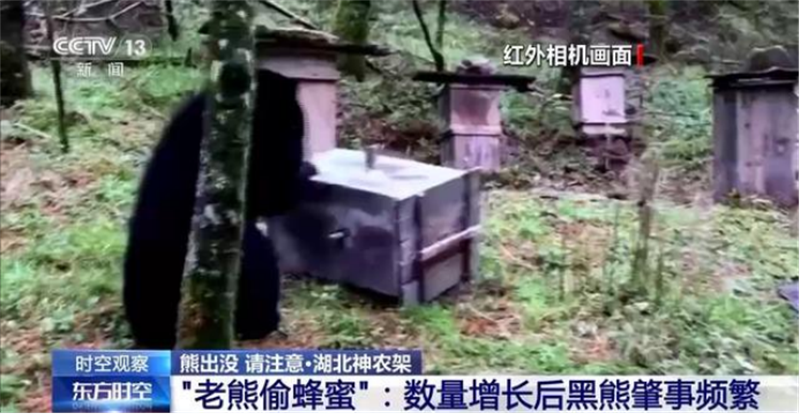Bear Alert! Building Harmony Between Humans and Bears
Updated:2024-11-19 Source:CCTV News
Among China’s large predators like wolves, tigers, and leopards, bears stand out with the largest population and widest distribution. Their extensive presence leads to frequent human-bear encounters, and further cause continual and serious incidents that showcase a rapid uptrend. Against this backdrop, how can we achieve sustainable coexistence between humans and bears?
Speaking of the conflicts between humans and bears, in the Jiangxi section of the Wuyishan National Park, an area rich in honey sources, Asiatic black bears are drawn to residents’ beehives. They frequently make their way into villages, households, and even the park’s conservation stations.
Under cover of darkness, an Asiatic black bear slipped into the Yejiachang Conservation Station in Wuyishan National Park’s Jiangxi section. Catching a scent, it began rummaging around the yard. Soon enough, the bear spotted its prize: a honey bucket suspended high above the ground. When jumping proved futile, the bear switched tactics. It simply climbed the nearby ladder, reached the bucket, and tore it open to feast on the honey inside. But the bear didn’t let it go at that. After its meal, it dragged the damaged bucket away with it into the night.

Under the national park system’s rigorous protection measures, wildlife populations throughout Mount Wuyi, including Asiatic black bears, have witnessed steady recovery in recent years. Evidence from infrared camera traps shows both a marked increase in bear sightings and a widening activity range.
“Old Bear Steals Honey”
Rising Asiatic Black Bear Numbers Lead to More Incidents
Shennongjia Forestry District in Central China’s Hubei Province, hailed as the “Kingdom of Plants”, boasts abundant natural resources. Lots of local farmers depend on beekeeping and fruit orchards for their livelihoods. Their production and living sites have also become a magnet for Asiatic black bears, turning the once-fanciful “old bear stealing honey” scene from animated stories into a daily reality.
Under cover of darkness, an Asiatic black bear crept into Tang Yinghong’s apiary. It seized a beehive and, with practiced ease, tore it apart. The bear dug out the honey and devoured it on the spot. Even after gobbling up the honey, it still seemed reluctant to leave away, dragging the beehive off into the shadows and disappearing from the camera’s view.
As the weather cools and Asiatic black bears prepare for hibernation, they need to stock up on energy. Due to food scarcity in the mountains, they are increasingly foraging in residential areas, targeting apiaries and orchards.

It’s wild kiwi fruit harvest season, but with Asiatic black bears frequently roaming the forests, locals are too scared to conduct fruit picking. They have no choice but to give up this gift from nature.
In recent years, due to strict national protection policies, the population of Asiatic black bears has increased notably. As encounters have become more frequent, so have incidents, bringing significant economic losses to local farmers.

Hu Quanhong, Chief Engineer of the Forestry Administration of Shennongjia Forestry District, Hubei Province, described, “Over the past three years, many cases of Asiatic black bears destroying beehives have happened, causing significant losses to local beekeepers. To address this problem, the Forestry Administration spends 4 million yuan each year on purchasing wildlife damage insurance for farmers. In total, the compensation over the past three years has exceeded 5 million yuan.”
Asiatic Black Bear Incidents Disrupt Daily Life in Yulong Naxi Autonomous County
In Yulong Naxi Autonomous County, Lijiang City, Yunnan Province, local residents’ frequent trips to the wilderness have led to more encounters with Asiatic black bears. These black bear incidents have not only caused property damage but also disrupted other aspects of residents’ daily lives and livelihoods.
Located in Southwest China’s Hengduan Mountains, Yulong Naxi Autonomous County, Lijiang City, Yunnan Province is a key habitat for Asiatic black bears. Due to strengthened conservation efforts in recent years, the bear population has grown significantly and their activity range has expanded, giving rise to more frequent encounters with local residents. According to the Forestry and Grassland Bureau of Lijiang City, Asiatic black bears now account for the second-largest group in wildlife-related incidents in the area, following closely behind wild boars.

Duan Ziyun, Deputy Director of the Forestry and Grassland Bureau of Yulong Naxi Autonomous County, Lijiang City, Yunnan Province, stated, “Since 2020, Yulong Naxi Autonomous County has experienced 2,046 wildlife-related incidents, including 758 cases of property damage and 10 attacks on humans by Asiatic black bears, a Class II nationally protected species.”
Yulong County and its surrounding villages are situated near mountains and rivers, where residents primarily make a living by farming and livestock herding. Additionally, foraging for wild mushrooms in summer and autumn serves as an important lifestyle practice and source of income. Consequently, these seasons usher in a peak of head-on encounters between Asiatic black bears and locals, often resulting in safety incidents and injuries. Moreover, common problems seen elsewhere, such as bears stealing honey and killing livestock, are even more prevalent in this region.

According to Wang Zhixiong, Employee of the Forestry Workstation in Liming Lisu Ethnic Township, Yulong Naxi Autonomous County, Yunnan Province, “Multiple incidents of bears damaging crops and injuring or killing livestock, particularly cattle and sheep, have happened in our jurisdiction. Upon receiving reports from farmers, we immediately visited the sites to investigate and document the damage with photographs. We found clear evidence of bear activities, including tracks and droppings. The main losses included cattle and sheep, corn, beehives, forests, and orchards.”

According to local forestry and grassland department, in recent years, it has intensified wildlife protection awareness through methods such as home visits and posting warning signs. As a result of these efforts, the local ecological environment has notably improved, leading to increasing populations of wildlife, including Asiatic black bears. In response, since 2013, the local government has provided farmers with wildlife damage liability insurance, covering direct economic losses from personal injury and property damage caused by wildlife. As eligible claims will be settled by insurance companies, insurance payouts totaling 4.83 million yuan have been used to indemnify the villagers over the past four years.
Ecological Environment Continues to Improve
Asiatic Black Bear Population Grows Rapidly
The frequency of bear-related incidents, including honey theft, has been on the rise. Why is this happening? And how can we achieve long-term coexistence with large predators like Asiatic black bears under China’s current ecological protection system? In the Shennongjia National Park in Hubei Province, Central China, experts from the Chinese Academy of Forestry in Beijing, together with the park’s researchers, have conducted a two-year monitoring survey on the Asiatic black bear population. Let’s take a closer look at their findings.
The Shennongjia National Park Candidate Area is a crucial habitat for Asiatic black bears in China. They are distributed across multiple vertical vegetation zones, inhabiting diverse types of forest zones at elevations ranging from over 900 meters to 2,600 meters. The wild chestnut forests, which stand at an elevation between 1,200 and 2,000 meters, are particularly favored by Asiatic black bears.

With increased conservation efforts, the ecological environment in the Shennongjia Forestry District has continued to improve, giving rise to higher reproduction rates and significantly better survival rates among Asiatic black bears. Infrared cameras placed in the wild frequently capture images of Asiatic black bears traveling in groups, including the footage of mother bears with three or more cubs. To accurately assess the Asiatic black bear population in the Shennongjia National Park Candidate Area, the Chinese Academy of Forestry, in collaboration with the Scientific Research Institute of Shennongjia National Park, conducted a targeted population survey in the candidate area.

Liu Fang, Associate Research Fellow at the Ecology and Nature Conservation Institute, Chinese Academy of Forestry, explained, “Over the past three years, we have set up three infrared camera ‘traps’ in areas with the highest concentration of Asiatic black bears within the Shennongjia National Park Candidate Area. The three cameras were positioned around a central bait area. When bears approached, they would stand, revealing the V-shaped white mark on their chest. By analyzing the shape of this mark, we can identify individual bears. Within an area of about 80 square kilometers, we have identified 11 distinct individuals. On this basis, we preliminarily estimate that at least 150 Asiatic black bears live in the Shennongjia National Park Candidate Area.”
Exploring Solutions for the Coexistence Between Humans and Bears
Compared to other large predators like wolves, tigers, and leopards, bears including brown bears and black bears tend to come into conflict with humans more frequently. These conflicts span a wider range of activities and affect more areas of human life. What solutions can we find to foster peaceful coexistence between humans and bears? Here are the experts’ insights.
Li Sheng, Research Fellow at the School of Life Sciences, Peking University, explained, “First, we need to enhance research and monitoring to better understand bear population growth and dynamics. Second, for people living in or visiting bear habitats, whether they are herders, locals, or tourists, it’s crucial to enhance publicity and education on bear presence in the area and how to safely respond if they encounter a bear.
Third, local residents should take proactive defensive measures, such as installing bear-proof fences and implementing early warning systems. Finally, in local areas where bear populations have grown to a level that poses significant risks, we may need to consider applying population control strategies to minimize conflicts between humans and bears.”
Address:36 Chulin Road, Muyu Town, Shennongjia Forestry District, Hubei Province 鄂ICP备18005077号-3
Phone:0719-3453368



